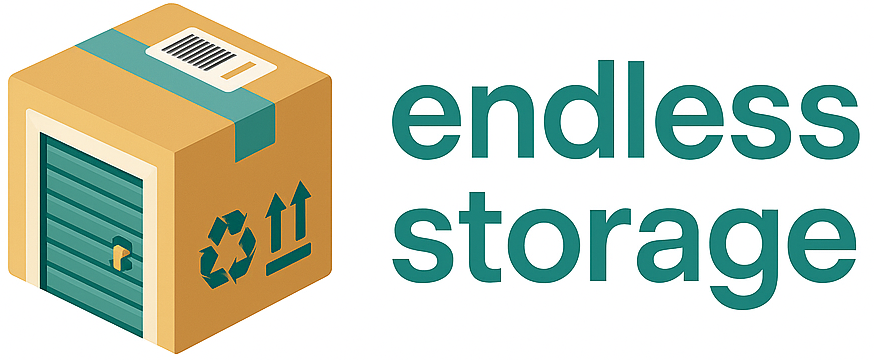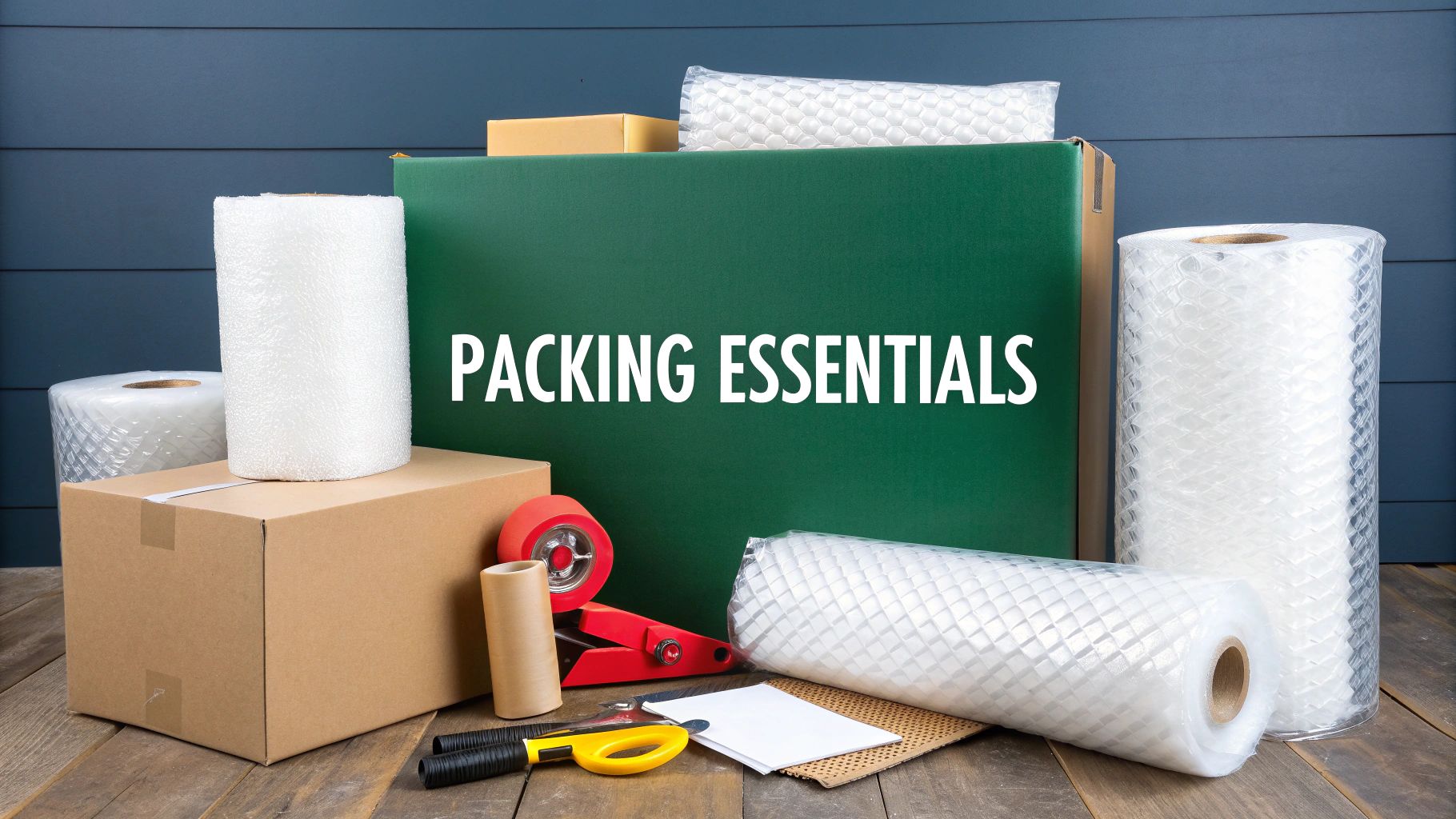When you're staring down the barrel of a move, the sheer number of things to do can feel like a tidal wave. But here's a secret from the pros: your first, most important step isn't lifting a single piece of furniture. It’s gathering the right supplies.
The best packing supplies for moving aren't just about boxes and tape; they are your entire toolkit for a stress-free transition. Think sturdy boxes, plush bubble wrap, strong packing tape, and the simple-but-essential markers and box cutter. Kicking things off with high-quality gear is the single best way to protect your stuff, keep things organized, and save yourself a massive headache later on.
Why the Right Supplies Are Your First Step
Let's be honest, moving can feel like controlled chaos. But the right tools transform that chaos into a well-oiled machine. Your packing supplies are your strategic arsenal. A chef wouldn't try to cook a gourmet meal with a dull knife and flimsy pans, right? The same logic applies here. Skimping on supplies is a recipe for disaster—cracked heirlooms, shattered dishes, and an unpacking process that feels like a nightmare.
Investing in proper moving supplies is about building a fortress of protection around your belongings. That free box from the grocery store might seem like a good deal, but it can easily collapse under the weight of your books. A purpose-built dish pack box, on the other hand, is engineered to shield your fragile kitchenware from bumps and drops. This guide will cut through the noise, showing you not just what to get, but why each item is a critical player in a damage-free move.
The Foundation of a Successful Move
Your moving toolkit really boils down to three core categories. Get these right, and you're setting the stage for everything to arrive at your new home exactly as it left the old one.
Containment: This is all about the boxes and bins that will hold your life's possessions. We’re talking everything from small, sturdy boxes perfect for heavy books to tall wardrobe boxes that let you move clothes straight from the closet.
Protection: These are the unsung heroes of any move. Cushioning materials like bubble wrap, packing paper, and thick moving blankets absorb shocks, prevent scratches, and fill empty spaces to stop items from shifting around. For your biggest and most valuable pieces, our guide on how to protect furniture when moving dives deep into specific techniques.
Execution: You can have the best boxes in the world, but they're useless without the right tools to put them all together. This category includes the essentials: a good packing tape dispenser (your hands will thank you), permanent markers for clear labeling, and a sharp, reliable box cutter.
When you arm yourself with a solid set of supplies, you’re doing more than just packing. You're actively managing risk and building a system for success from the very beginning.
To get a bigger picture of the entire moving process, from planning to settling in, this ultimate Dallas relocation guide is a fantastic resource that covers the journey beyond just the packing stage.
Essential Packing Supplies at a Glance
To make building your moving kit easier, here's a quick-reference table that breaks down the must-have supplies and what they're used for. Think of this as your shopping list for a smooth, damage-free move.
With this toolkit in hand, you'll be well-equipped to tackle the packing process with confidence, knowing your belongings are safe and secure for the journey ahead.
Choosing the Best Moving Boxes and Containers
Think of moving boxes as the foundation of your entire move. Just like a chef has specific knives for different tasks, you need the right box for the job. It’s not just about finding something to hold your stuff; it’s about choosing a container with the structural integrity to protect what’s inside.
The right box doesn't just store your things—it safeguards them. A classic rookie mistake is grabbing the biggest box you can find and stuffing it with heavy items like books. That’s a surefire recipe for a box that splits open and a back you’ll be complaining about for weeks.
Here’s the golden rule every pro mover lives by: heavy items go in small boxes. Lighter, bulkier items can go in the larger ones. This simple principle keeps the weight of each box manageable and prevents collapses.
Standard Cardboard Boxes: The Workhorses of Your Move
There's a reason standard cardboard boxes are everywhere—they're affordable, recyclable, and come in a handful of sizes that cover most of your needs. They are the true workhorses of any move.
- Small Boxes (1.5 cu. ft.): These are your go-to for anything dense and heavy. We're talking books, canned goods from the pantry, tools, and smaller kitchen appliances. Their compact size physically stops you from making them too heavy to lift.
- Medium Boxes (3.0 cu. ft.): The all-rounder. These are perfect for most things in your home, from pots and pans to toys and general decor. They hit that sweet spot between providing enough space and staying easy to carry.
- Large Boxes (4.5 cu. ft.): Only put your lightest, fluffiest items in here. Think pillows, comforters, lampshades, and bulky sweaters. Overloading these is the number one cause of a moving day disaster.
This infographic breaks down the essential supplies that form the backbone of a smooth, organized move.
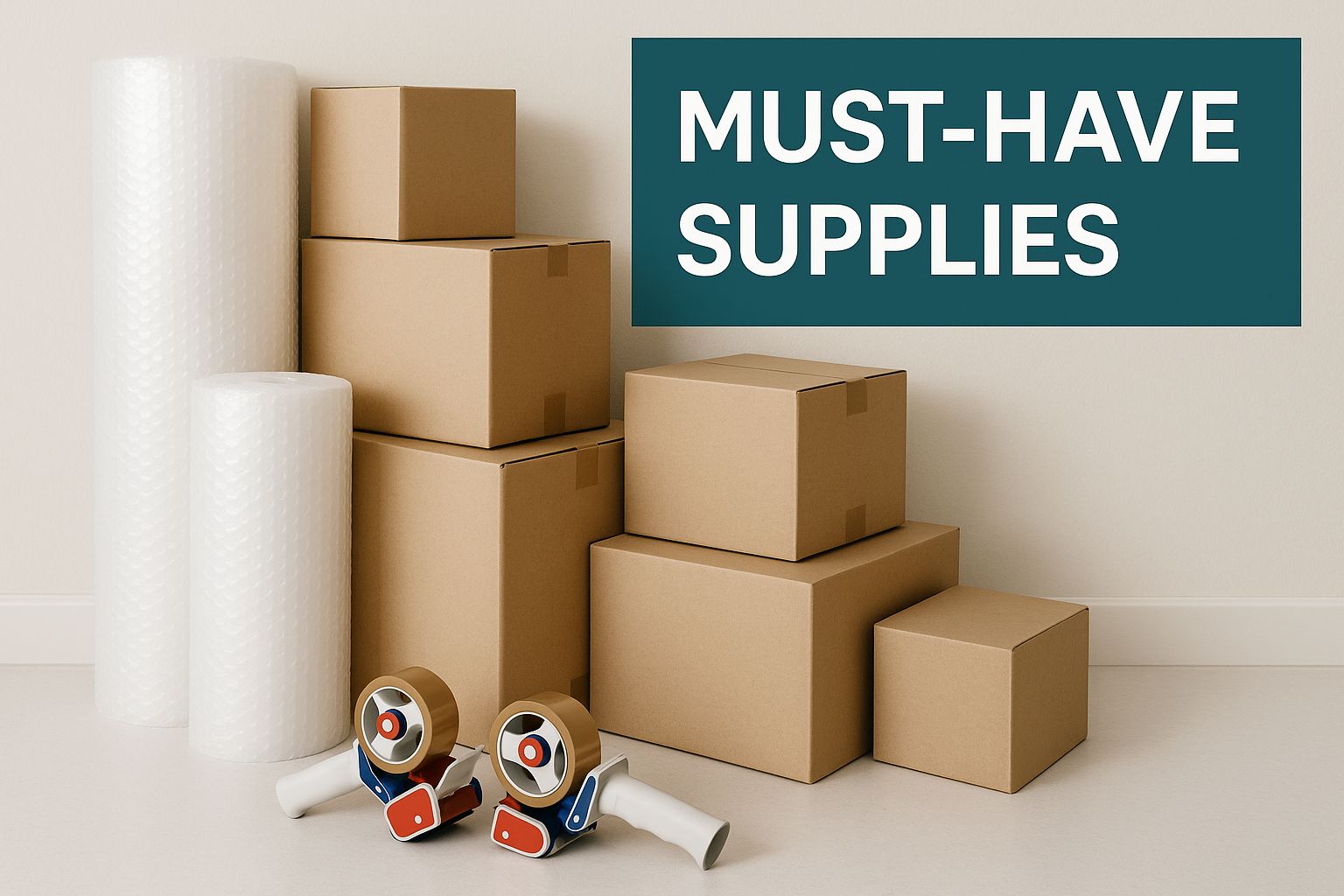
As you can see, it’s all about how these simple items—good boxes, strong tape, and the right cushioning—work together as a system to keep your belongings safe.
Specialty Containers: Insurance for Your Valuables
While standard boxes will get most of the job done, some items need a little extra TLC. Specialty containers are a smart investment, providing superior protection that can save you from costly damage and heartache later.
Wardrobe boxes, for instance, are basically portable closets. You can move clothes straight from your closet, hangers and all, without them getting wrinkled or crushed. Dish pack boxes are built with double-thick walls, giving your fragile plates and glasses the extra cushion they need to survive the trip. A dedicated picture or mirror box offers a snug, secure home for your artwork, acting like an insurance policy against cracked glass and broken frames.
For more pro-level packing strategies, our ultimate guide on how to pack moving boxes will help you get it right.
Choosing the right box is the first line of defense in protecting your belongings. The structural design of a specialty box is specifically engineered to absorb shock and prevent the very damage a standard box might allow.
It’s no surprise that people are investing more in quality supplies. The global moving boxes market was valued at around USD 2.5 billion in 2025 and is set to grow as more people recognize their importance. While classic cardboard is still king, durable plastic bins are catching on for their reusability and unmatched sturdiness. This trend just goes to show how critical good packing materials are for a successful move.
Mastering Protective Materials for Fragile Items
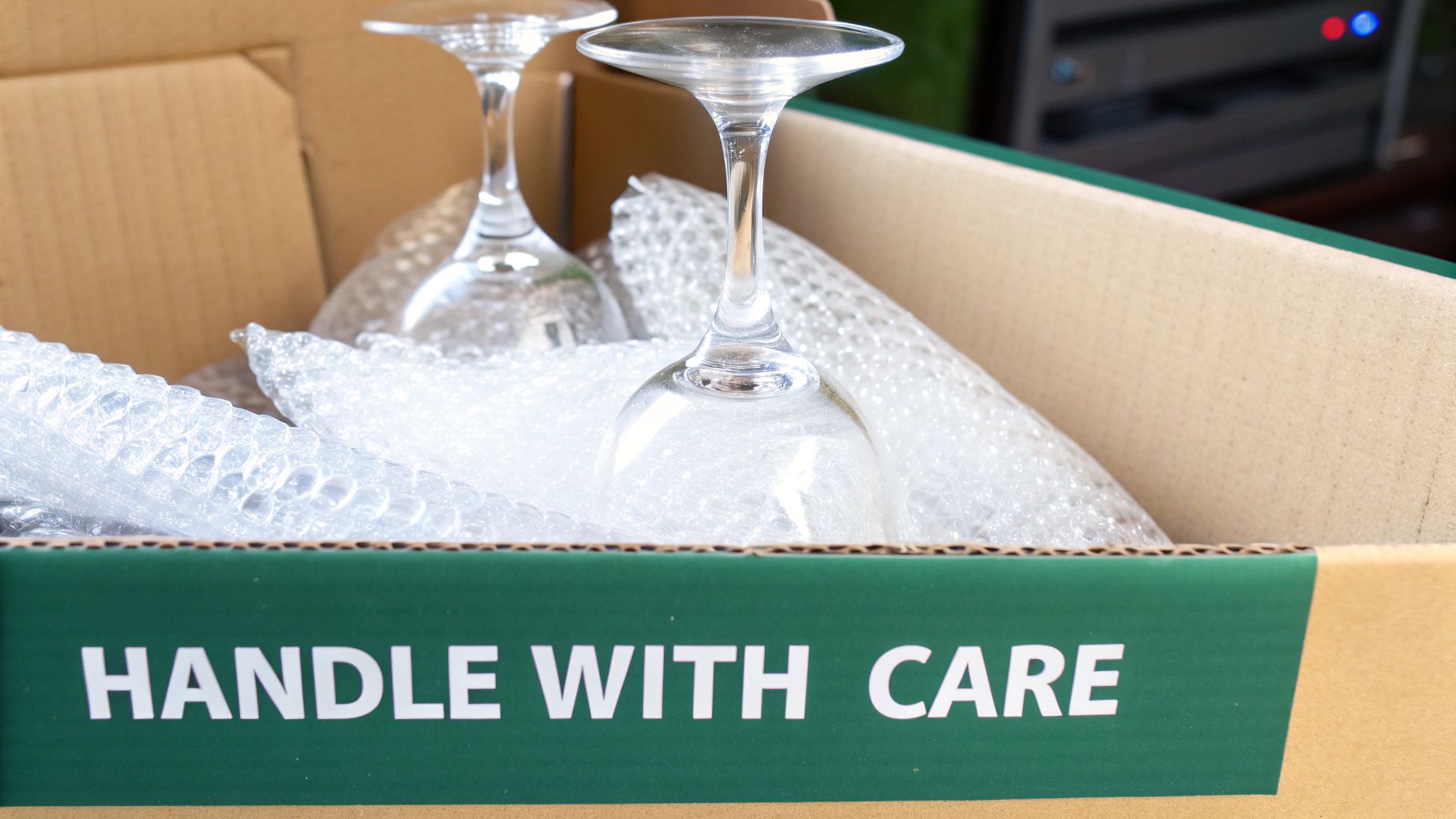
The real secret to a damage-free move isn’t just about the box—it’s about what goes inside it. Think of protective materials as the personal bodyguards for your cherished belongings. A sturdy box is the armored truck, sure, but it's the bubble wrap and packing paper that act as the security detail, absorbing shocks and stopping your valuables from rattling against each other.
Without that crucial cushioning, even the strongest box in the world can't prevent a ceramic vase from cracking or a picture frame from shattering. These materials fill up all the empty space, creating a buffer zone that turns a moving truck's normal vibrations from a destructive force into a gentle hum. They're an absolutely non-negotiable part of any list of the best packing supplies for moving.
This need for proper protection is a big reason the moving supplies market has exploded. What was a global market valued at around USD 741.8 billion in 2025 is expected to shoot past USD 1.18 trillion by 2035. As more people move for work and life changes, the demand for reliable gear to protect their stuff just keeps climbing.
The Right Cushioning for the Right Job
Here's the thing: not all protective materials are created equal. Each one has a very specific job to do, and using the right tool is the difference between an item arriving in one piece and an item arriving in pieces.
- Packing Paper: This is your everyday workhorse. It’s perfect for wrapping individual plates, glasses, and other kitchen items. You can also crumple it into balls to line the bottom and top of boxes, creating a soft, protective nest.
- Bubble Wrap: When you need serious shock absorption, bubble wrap is your go-to. This is what you break out for electronics, delicate figurines, and framed artwork. Those little air-filled pockets are a superior buffer against any bumps and drops.
- Foam Pouches: For flat, fragile things, these pouches are a game-changer. Just slide plates, small mirrors, or picture frames into these pre-made sleeves for a snug, scratch-proof layer of protection.
- Moving Blankets: Your biggest items need protection, too. Drape these thick, padded blankets over furniture, large appliances, and TVs to shield them from nicks, dents, and dust while in transit.
The golden rule for packing fragile items is simple: eliminate all movement. When you wrap each piece individually and fill every single void, you create a solid, stable block inside the box that can handle the bumps and shakes of the road.
Pro Techniques for Flawless Protection
Once you've got your supplies, knowing how to use them correctly is what really counts. The pros rely on a few simple but incredibly effective techniques to make sure everything stays put. For a more in-depth look, check out our guide on the best packing materials for fragile items.
One of the most useful but often forgotten tools is stretch wrap. Think of it as industrial-strength plastic wrap. You can use it to tightly secure moving blankets around furniture or wrap it around a dresser to keep the drawers from flying open mid-move. It’s a simple roll of plastic that can save you a world of trouble.
When packing a box of breakables, always start by laying down a thick, soft base of crumpled packing paper. Wrap each item on its own before placing it inside. Then, the most important step: fill all the remaining gaps with more crumpled paper before you seal the box. You want to make sure nothing can shift even an inch.
Essential Tools That Streamline Your Move
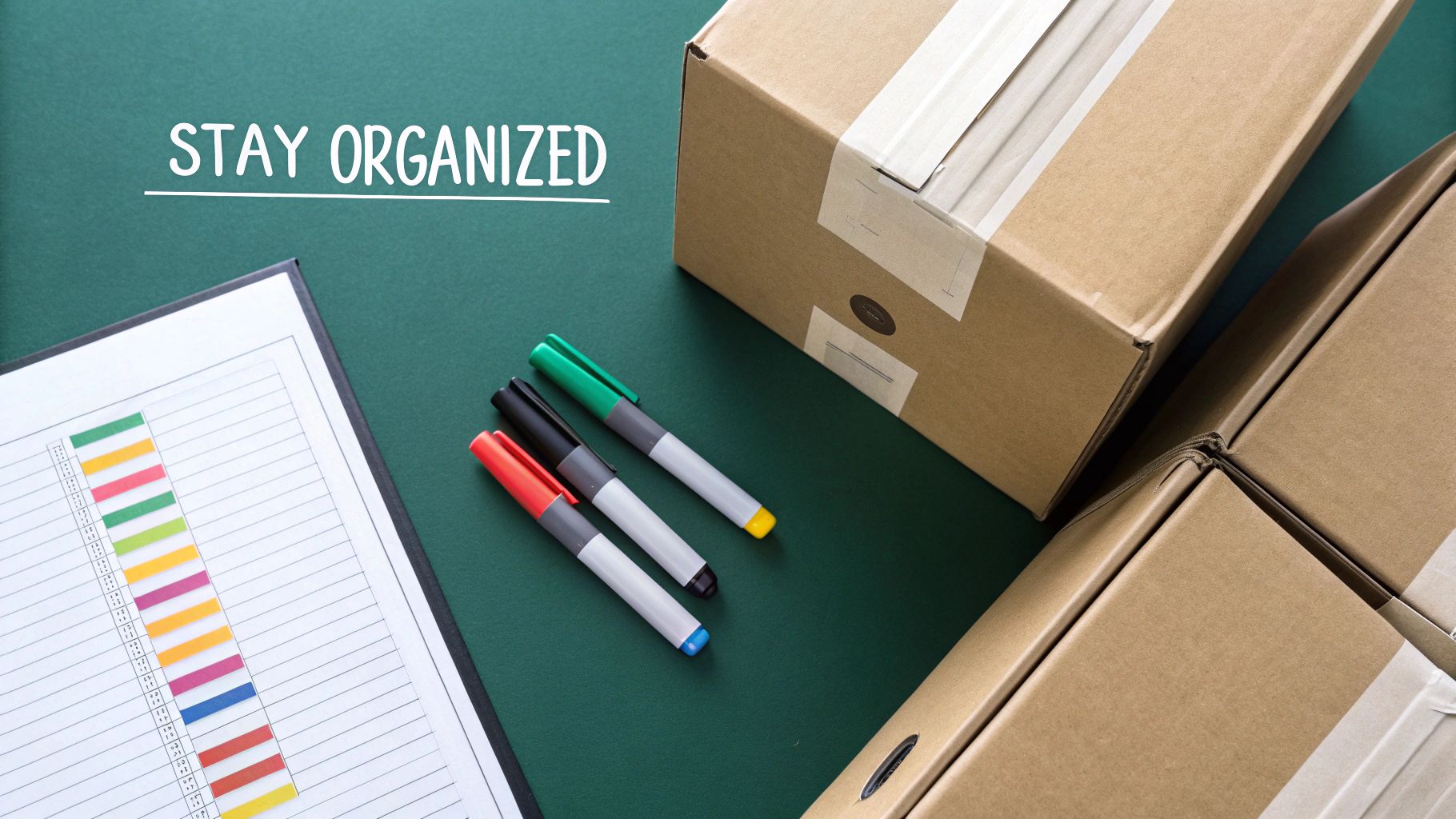
Sure, boxes and bubble wrap get all the glory, but it’s the smaller accessories that make the real difference between a chaotic move and a smooth one. These are the unsung heroes of your moving toolkit, the things that save you time, sanity, and a whole lot of headaches.
Think about it this way: working smarter is always better than working harder. We’ve all been there, trying to find the end of a tape roll and just giving up and cutting it with our teeth. A proper tape dispenser, on the other hand, makes sealing boxes a quick, one-handed job. That simple tool saves you a ton of frustration over the course of packing dozens of boxes.
The Unsung Heroes of Packing
The line between an amateur packer and a pro often comes down to having the right gear. These items might seem small, but they are absolutely part of the best packing supplies for moving and will make you far more efficient.
- Quality Tape Dispenser: A weighted, handheld dispenser is a must. It gives you tension and a sharp cutting edge so you can seal boxes fast without fumbling around.
- Permanent Markers: Your future self will thank you for this. Use bold, black markers to clearly label the contents and which room it belongs in on at least two sides of every box.
- Box Cutter or Utility Knife: A sharp blade is non-negotiable for both safety and speed. You'll use it for everything from cutting tape and breaking down boxes to trimming packing materials to the perfect size.
- Basic Toolkit: Keep a small kit nearby with a screwdriver, Allen wrenches, and pliers. You'll need it for taking apart bed frames, table legs, and all sorts of other furniture.
A well-organized move hinges on efficiency. Every minute saved by using the right tool, like a tape dispenser or a pre-labeled marker, adds up to hours saved over the entire process, reducing stress and physical fatigue.
This kind of preparation is what prevents unpacking from becoming a total mess. No more opening ten different boxes just to find the coffee maker.
Gear That Protects You and Your Belongings
Beyond just sealing and labeling, a few other pieces of equipment are critical for protecting both you and your heavier stuff. Skipping these can easily lead to strained muscles, scratched floors, or damaged furniture—all problems you can easily avoid.
A furniture dolly or hand truck might be the single most important tool you can get. It turns the miserable task of moving a heavy filing cabinet or a wobbly stack of boxes into a simple roll across the floor, saving your back from a world of hurt. Even for short trips from a room to the moving truck, a dolly is a complete game-changer.
Just as important are a good pair of work gloves. Handling dozens of cardboard boxes can really tear up your hands, leaving you with annoying cuts and scrapes. A solid pair of gloves gives you a better grip and protects your skin, letting you work comfortably for much longer. These aren’t luxuries; they're essential for a safe move that gets you and your belongings to your new home in one piece.
Packing Strategies the Professionals Use
Having all the right moving supplies is a great start, but knowing how to use them is what really separates a chaotic move from a smooth one. Professional movers have this down to a science, using proven strategies that make packing faster and safer. These aren't complicated trade secrets; they're simple, smart techniques that anyone can learn.
Think of it like cooking. You can have the best ingredients in the world, but if you don't follow the recipe, the final dish will be a disaster. Professional packing strategies are the recipe for a successful move, ensuring your stuff arrives in one piece and making the unpacking process intuitive, not overwhelming.
There's a reason the global moving services market was valued at a whopping USD 111.23 billion in 2025 and is still growing. A huge chunk of that—about 43.6%—comes from residential moves, as more people relocate for work or a change of scenery. Pro services do well because they offer to take the stress out of the entire process, and expert packing is a massive part of that promise. You can learn more about the trends in the moving services market to see just how much people value this expertise.
Create an Intelligent Labeling System
Simply scribbling "Kitchen" on a box with a marker isn't a system. Professionals use detailed labeling to make unpacking a breeze. Instead of a generic room name, get specific: "Kitchen - Pots & Pans" or "Living Room - Books." This tiny bit of extra effort will save you from tearing open ten boxes just to find the coffee maker on your first morning.
For next-level organization, try a color-coded system. It's simple:
- Blue: Kitchen
- Red: Master Bedroom
- Green: Living Room
- Yellow: Bathrooms
Just assign a color to each room and slap a matching sticker or piece of colored tape on every box. When you get to your new place, you can tell movers (or helpful friends) exactly where each box goes with just a glance—no reading required.
Pack a "First Night" Essentials Box
This might be the single most valuable trick in the professional mover's playbook: the "first night" box. This is one box that doesn't go on the moving truck; it travels with you in your car. It’s packed with everything you'll need the moment you walk through the door, saving you from a frantic search after a long, tiring day.
Your essentials box is your survival kit for the first 24 hours in a new home. Pack it with items that bring immediate comfort and function, and you'll turn a potentially stressful night into a manageable, even pleasant, experience.
So, what goes inside? Think about what you'll need right away:
- Toilet paper and hand soap
- A change of clothes for everyone in the family
- Phone chargers
- Basic toiletries (toothbrushes, toothpaste, etc.)
- A small toolkit with a screwdriver and a box cutter
- Snacks and bottled water
This simple step ensures you can unwind and recharge before you even think about tackling the mountain of other boxes. Our guide on how to pack efficiently for a move has even more tips like this to keep you organized.
Master the Art of Weight Distribution
Finally, pros know how to load a box for maximum safety and stability. The golden rule is simple: heaviest items on the bottom, lighter items on top. This creates a low center of gravity, making the box way less likely to tip over in transit or crush the delicate items inside.
Don't forget to fill in any gaps! Crumple up packing paper and stuff it into all the empty spaces. This stops your belongings from shifting around, which is one of the main reasons things get broken during a move.
Common Questions About Packing Supplies
Even the most organized move comes with a few questions. When you're standing in the aisle of a hardware store, it’s easy to feel a little lost. Getting a handle on the basics helps you spend your time and money wisely, so you can walk into packing day feeling like a pro. We've rounded up some of the most common questions we hear to give you some clear, practical answers.
How Many Moving Boxes Do I Really Need?
Trying to guess the right number of boxes is a classic moving headache, but you don't have to guess blindly. A good rule of thumb is to plan for roughly 10-15 small, 15-20 medium, and 5-10 large boxes for every room you're packing up.
Of course, this is just a starting point. A minimalist with a one-bedroom apartment might get by with 30-40 boxes total. On the other hand, a family in a three-bedroom house could easily need 80-100 boxes or more. It's always a good idea to buy about 10% more than you think you need. Most places will let you return clean, unused boxes anyway.
The biggest mistake people make is forgetting about all the little things tucked away in drawers, closets, and cabinets. Having those extra boxes on hand means you won't be scrambling at the last minute or trying to dangerously overstuff them—which is the number one reason boxes break.
Are Specialty Boxes for Wardrobes or Dishes Worth It?
One hundred percent, yes. They might seem like an extra cost upfront, but think of specialty boxes as an investment in making your life easier and protecting your stuff. They're designed for specific jobs that a standard box just can't handle.
Take wardrobe boxes. They let you move clothes straight from your closet, hangers and all. This saves an incredible amount of time on both ends of the move and keeps your clothes from turning into a wrinkled mess. Dish pack boxes are another game-changer. With their double-thick walls, they provide the heavy-duty cushioning your plates and glasses need, drastically reducing the chances of anything breaking. It's cheap insurance for your most fragile possessions.
Can I Find Free Moving Supplies?
You definitely can! It's possible to snag free boxes from local grocery or liquor stores, and you can often find people giving them away on community marketplaces online. This is a great way to cut down on costs, but it comes with a few warnings.
Used boxes can have a secret history. They might be weaker from wear and tear, hiding dirt or moisture, or even carrying unwanted pests. They can be perfectly fine for non-breakables like towels or books, but always give them a thorough inspection first. When it comes to your valuables, nothing beats the peace of mind that comes from using new, sturdy boxes.
What Is the Best Tape for Sealing Moving Boxes?
The tape you use is just as critical as the box itself. You want a high-quality packing tape with a strong adhesive—look for acrylic or hot melt types. Make sure it's at least two inches wide to create a solid seal that won't give out when the box is lifted or stacked.
Whatever you do, don't reach for duct tape or masking tape. Duct tape doesn't stick well to cardboard, and masking tape is nowhere near strong enough to hold. Both are almost guaranteed to fail, especially with changes in temperature or humidity, leaving your boxes to pop open at the worst possible moment. Once you've got your supplies, figuring out what to pack first when moving is the perfect next step.
Feeling overwhelmed by the sheer amount of stuff you need to pack and store? Endless Storage offers a simple, box-by-box storage solution. We send you the supplies, you pack, and we pick it up for secure storage, delivering it back whenever you need it. https://www.endless-storage.com
Frequently Asked Questions
Unveiling the Secrets to Effortless Storage
Endless Storage is available nationwide. You pick a plan, tell us where to pickup, and we'll send a UPS van to collect, whichever state you're in.
Your shipping label will be sent to your email within a few minutes, if not instantaneously. It can also be accessed through your customer profile.
Your box will be shipped to one of our climate controlled self storage facilities in our closest self storage facility. Our manager will accept your package, notify you that your box has been received, and securely stored. Only our managers will have access to Endless Storage boxes.
Email us at admin@endless-storage.com click to live chat with us, or send us a message below.
Never! We're committed to transparent pricing with no surprises. You'll lock in your rate with no hidden fees and no long-term contracts.
Fast access guaranteed! Your boxes will arrive at your doorstep within 48 hours of requesting them back. Need to check on delivery? We provide tracking information for complete peace of mind.
Totally flexible! Store month-to-month with no long-term commitment and cancel anytime.
Everything's online! Use your account dashboard to:
• Set up automatic monthly payments
• Request box returns
• Update your address
• Order additional boxes
• Track shipments
Your boxes are insured up to $100 each. Our customer service team will help you file any necessary claims and resolve issues quickly.
Don't worry – we'll email you right away if there's a payment issue. Your items stay safe, though you may have temporary service interruption or late fees until payment is resolved.
When you request our free storage kits, you'll have 30 days to send in your boxes to activate your 3 months of free storage. Think of it like starting a gym membership – your activation window begins when you receive your kits, and your full free trial begins once you send in your first box. During your free months, you'll experience our complete storage service at no cost.
Your 30-day activation window begins when you receive your storage kits. We'll send you an email confirmation when your kits are delivered, marking the start of your activation period.
If you haven't sent any boxes for storage within your 30-day activation window, your free trial will expire and we'll begin charging the regular monthly rate of $9.99 per box. This helps ensure our storage kits go to customers who are ready to use our service.
A box costs $9.99 per month to store (plus sales tax). This price includes free shipping for standard boxes under 50 lbs. and smaller than 16"x16"x16"
Log into your Endless Storage account, locate the box you would like returned, and simply click Return My Box.
Yes, each box stored with us is insured for up to $100 throughout transit as well as the duration of storage within our facilities.
Your box will be at your doorstep within 48 hours of you requesting it back.
Store 10+ boxes? We'll pick them up for free! After your purchase, we'll contact you to schedule a convenient pickup time and arrange UPS collection.
We trust UPS with all shipments, and every box includes $100 insurance coverage. You'll receive tracking information to monitor your items' journey.
Yes! Visit any of our locations by appointment. Just bring a photo ID matching your customer profile.
For everyone's safety, we can't store hazardous materials, firearms, or perishables. All items must fit within our standard boxes.
It's easy! Order your storage kit online, and we'll ship it to you within 1-2 business days. Your shipping labels will be emailed instantly and available in your account.
We're here to help! Email us at admin@endless-storage.com, use our live chat, or send us a message through your account.
To cancel your storage service with Endless Storage, please email your cancellation request to admin@endless-storage.com. Our team will process your request within 2 business days and confirm your cancellation via email.
We understand packing takes time. However, to maintain your free trial benefits, you'll need to send at least one box within the 30-day activation window. If you need more time, you can always start with one box to activate your trial and send the rest later. You can always reach out to admin@endless-storage.com if you have any issues or concerns.
When you request our free storage kits, you're starting a 30-day window to begin using our storage service.
To avoid any charges, simply send at least one box for storage within 30 days to activate your 3-month free trial. If you decide not to use our service and don't send any boxes within the 30-day window, a one-time $50 fee will apply to cover the costs of materials and shipping. This helps ensure our storage kits go to customers who are ready to use our service.
Think of it like reserving a hotel room – we're setting aside space and sending specialized packing materials for your use. The fee only applies if you request materials but don't begin storage, similar to a hotel's no-show charge.
